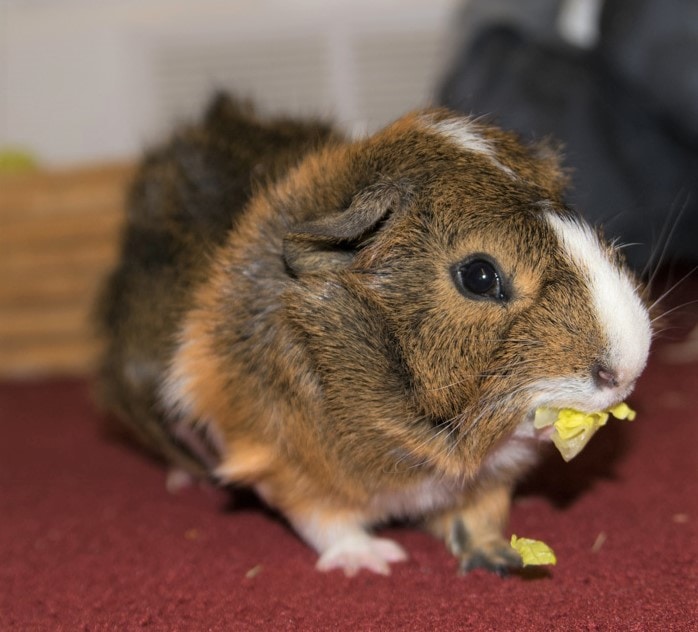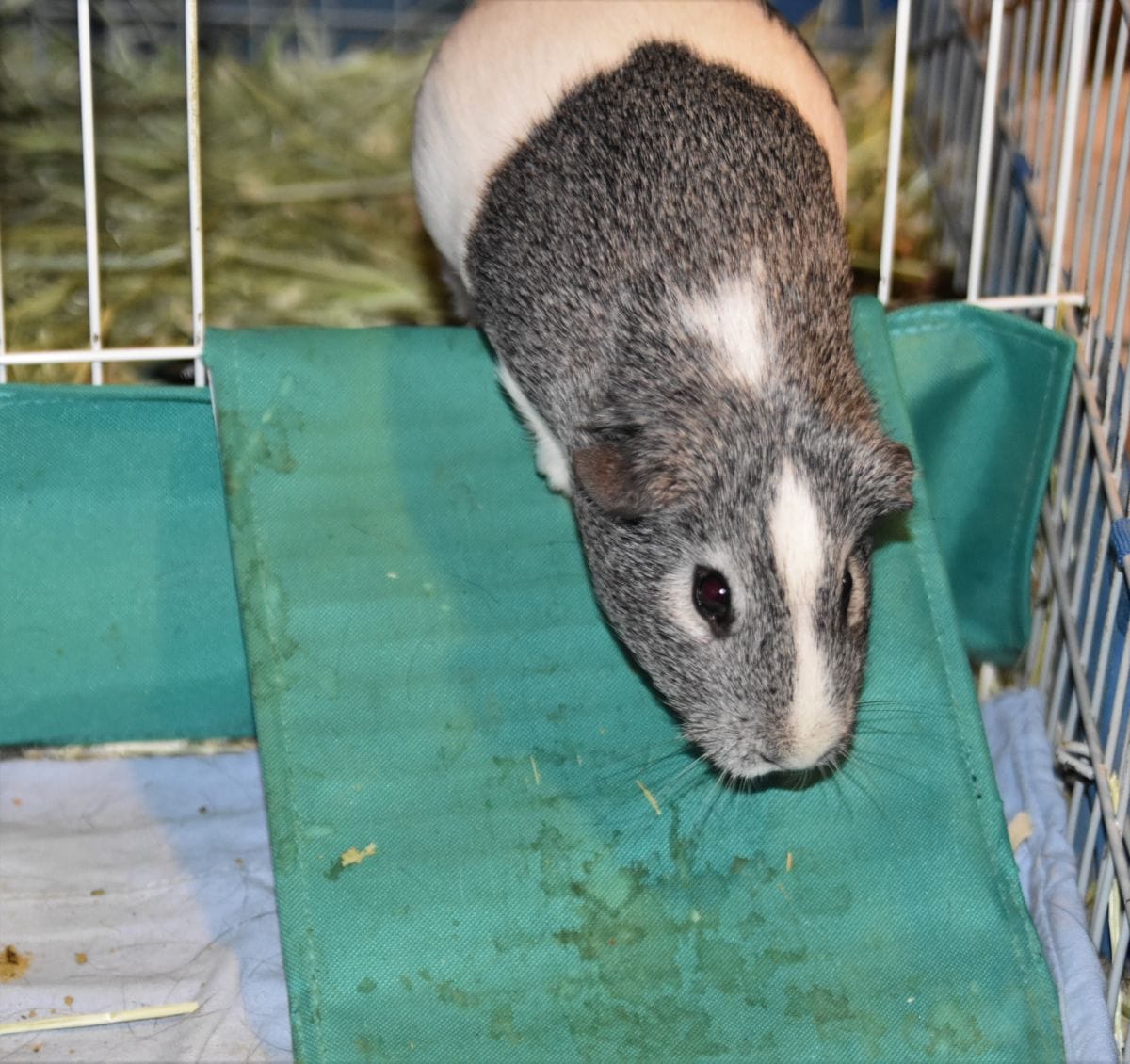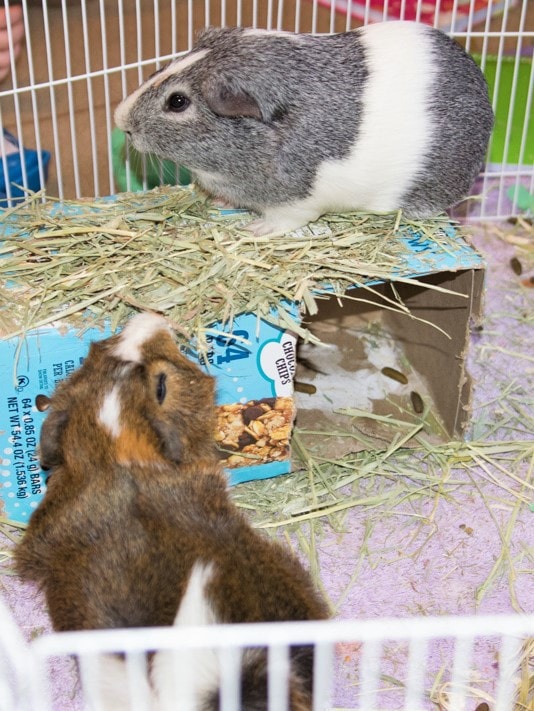Guinea pigs are very smart and can learn many interesting and amusing tricks, but how do you get your guinea pig to the point where you can start teaching it tricks? In this article, I will tell you how.
In order to get your guinea pig to the point when you can teach it tricks, you will need to bond with it. To develop a strong bond with your guinea pig, you should hand feed it vegetables and other foods daily as well as talk to it to get it used to your voice. Also, let it play with you outside of the cage often.
Let’s dive a little deeper into bonding and training a guinea pig before you attempt to teach it tricks.
As I mentioned earlier, one of the most effective ways to tame your guinea pigs is by hand feeding them vegetables and other foods that they like. You should hand feed the guinea pigs large pieces of food at first, then make the treats smaller and smaller as the guinea pig becomes more used to you.
Talking to it while you hand feed is another effective way to get it used to you. Holding it and letting it play outside the cage with you regularly is another excellent way to tame it. Once your furry friend will take bite sized pieces of food out of your hand, it may be tame enough to start learning a few tricks.

Before you begin training your furry friend, first of all, find its favorite treats by letting it try out several different kinds. There are some good treat options at pet stores, but vegetables—and fruits from time to time—are healthier as long as they’re safe for guinea pigs.
Some vegetables and fruits that are safe for guinea pigs include bell pepper (never hot peppers such as jalapeño), lettuce, carrots, cucumbers, zucchini, strawberries or apples.
Once your guinea pig is comfortable with you, you will need to decide if you want to ‘clicker train’ them or use a verbal marker. If you use a clicker, make sure that the sound isn’t too loud or sharp for their sensitive ears; a clicky pen often makes a good clicker for guinea pigs.
If you decide to use a verbal marker, you’ll need to use the same word or sound each time (a sound is often easier for a guinea pig to understand then a word) and only use it for training.
You will also need to find a suitable place to train them. The area should be free of loud noises or other distractions and your guinea pig should be familiar with the area—for example, it could be the room that their cage is in or in the place that they have play time.
Also find out when and how long you should train them. A good amount is 5 to 15 minutes each day, depending on how long of an attention span your guinea pig has and how much time you can put into training them.

Next you will need to gather the supplies you’ll need for training such as a clicker (if you use one) and treats. Treats used for training should be cut or torn into small pieces and be easy to chew so that the training will go faster.
To start with the actual training process, your guinea pig must understand that the clicker or verbal marker means that a treat is coming.
To teach the guinea pig this, just click the clicker (or say the marker) then immediately give him (or her) a treat. Do this until the guinea pig understands that when they hear the clicker or marker, they will get a treat. Once they understand this, you can move on.
Now start thinking about which methods you would like to train them with. There are 4 basic ways to train guinea pigs, Luring, Targeting, Shaping or Capturing. Some tricks can only be taught with one method of training while others can use multiple ways. Let’s talk about each method of training more deeply.

1. Luring
Luring is training your guinea pig by luring them into position with a treat. This method of training is great for guinea pigs with short attention spans. Just make sure to give them the treat every so often so that they won’t give up on whatever trick they’re learning. Also make sure that the guinea pig likes the treats that you use to lure them with because if they don’t, they won’t follow the lure.
Once they know the trick well enough, start to move the lure more quickly so the guinea pig isn’t relying on it as much. Next, start using a smaller and smaller treat until your guinea pig doesn’t rely on the lure very much anymore—but they still may need a little help from a treat every once in a while if they forget what to do next.
Example: Teaching a guinea pig to stand on its back legs by holding a treat above his (or her) head so that the only way the guinea pig can reach it is by standing on its back legs. Once it does this say a keyword such as ‘beg,’ then click and give him (or her) a treat.

2. Targeting
Targeting is sort of like luring except instead of luring them with a treat you lure them with a target. A great item to use as a target is a long stick; you can also use your finger or hand, though. To teach your guinea pig to follow a target, take them out to the place where you will train them, bring out the target and if they touch it with their nose (or paw), click, and give him (or her) a treat.
Example: Teaching a guinea pig to ‘high-five’ you by using your hand as a target for the guinea pig to touch with their paw. When it does this, say a word such as ‘high five,’ then click and give it a treat.


3. Shaping
Shaping is a step by step process. There are two ways of shaping, free shaping and shaping with luring.
Shaping with luring is guiding a guinea pig to each step then giving them a small treat after each one.
Free shaping is, instead of guiding the guinea pig to each step to teach it a trick, wait until they completed the step on their own, then click and reward them with a treat. Do this until they have completed the actual trick.
Example (with luring): Teaching a guinea pig to put both their front paws on your hand while your hand is pretty high above the ground by luring them onto your hand when it’s on the ground. Click and give him (or her) a treat. Move your hand higher and higher above the ground each time until it’s at the height you would like, and add a cue.
Example (free): Waiting for the guinea pig to put its paws on your hand by itself then click and treat. Move it higher and higher above the ground at each try. Once it’s at the height you want, add the cue.
4. Capturing
Capturing can be an easier way to teach guinea pigs tricks but you will need to have a clicker and treats available often when you interact with it. Capturing isn’t actually teaching the guinea pig a trick; you just watch it and if it does something interesting then you can say a cue; click and give him (or her) a treat.
However, with this type of training you have to watch your guinea pig a lot to see if it does something interesting.

If your guinea pig is refusing to follow the treat or target, go back a step and reward them more often.
As you hopefully can tell by now, guinea pigs are smart and can learn all kinds of neat tricks from standing up on their back legs to giving you a high-five! Also remember if either you or your guinea pig becomes stressed about the training, put your guinea pig back in its cage, then try again later.
Above all, remember to be gentle, patient and kind to your guinea pig while training it.




